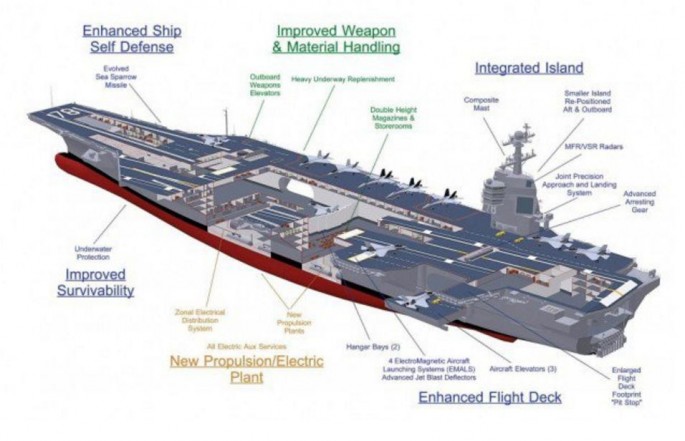The U.S. Navy has announced construction of its much delayed and problem-plagued new supercarrier, the USS Gerald R. Ford (CVN-78), is 99 percent complete and expects the warship will be launched by April at the earliest.
The Gerald R. Ford is the lead ship in a new class of supercarrier that will complement the existing fleet of 10 Nimitz-class supercarriers. She will directly replace the USS Enterprise (CVN-65) that was retired in 2012.
She was to have been launched in 2014 but numerous technical problems and cost overruns delayed her launch to this year - hopefully.
"Gerald R. Ford is 99 percent overall complete with 93 percent of the test program complete," said Navy spokesperson Capt. Thurraya Kent.
"Over the past few months, we have made significant progress resolving first-of-class issues associated with these critical systems and have resumed critical path testing in support of Builder's Sea Trials."
CVN-78 was to have joined the fleet in March 2016 but teething troubles with its new systems have pushed that back to an uncertain date later in 2017 or 2018.
Navy Secretary Ray Mabus said there has been progress in resolving troublesome issues on the Gerald R. Ford (one of which is its advanced arresting gear) but hesitated to predict when the $12.9 billion first-in-class warship first will join the fleet.
The delay is preventing the Gerald R. Ford from going to sea and beginning engineering trials. The ship remains moored at Newport News Shipbuilding in Virginia.
The Navy plans to have 10 ships in the Gerald R. Ford-class. Three have been announced. Apart from the Gerald R. Ford, the other two carriers in the class are the USS John F. Kennedy (CVN-79) and the USS Enterprise (CVN-80).
The Gerald R. Ford-class is a class of supercarriers being built to replace some of the Navy's existing Nimitz-class carriers.
The new warships have a hull similar to the Nimitz carriers, but introduce new technologies such as the Electromagnetic Aircraft Launch System (EMALS); the advanced arresting gear (AAG) plus other design features that improve efficiency and cut operating costs.



























